The Comprehensive Guide to Roof Decking: Materials, Installation, and Maintenance
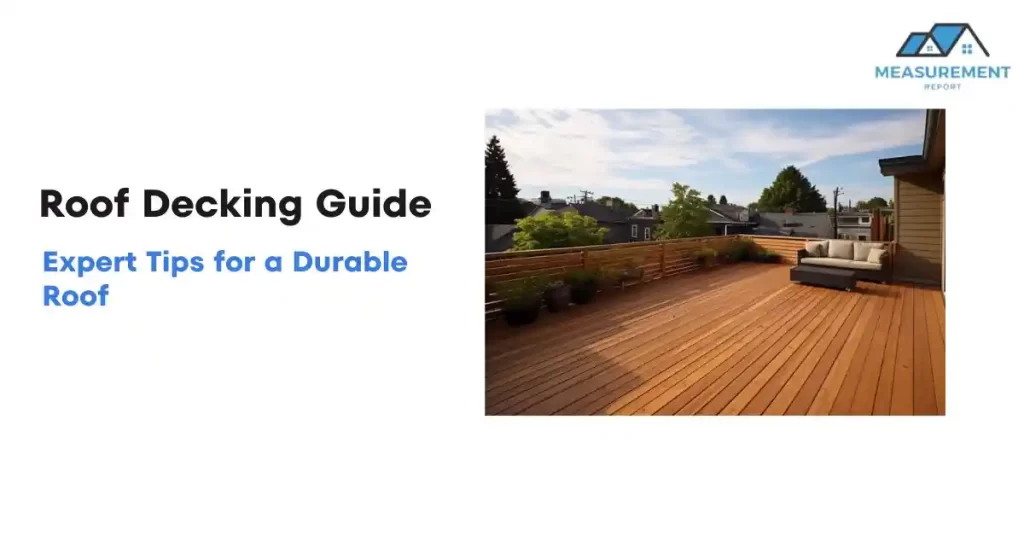
Roof decking, an integral yet often overlooked component in roof construction, serves as the foundational layer over which all other roofing materials are laid. This critical element not only supports the weight of your roof coverings but also contributes significantly to the overall structural integrity of your home. As such, understanding what roof decking is and its pivotal role in home maintenance is essential for any homeowner or construction enthusiast.
In the realm of home improvement and roof construction, the choice of decking material, the precision of its installation, and its maintenance can have far-reaching implications on the durability and performance of your roof. From withstanding harsh weather conditions to providing essential support for insulation and waterproofing layers, roof decking is the unsung hero of your home’s exterior defense system. In this comprehensive guide, we delve into the nuances of roof decking, exploring its types, installation processes, and maintenance practices, ensuring you have all the information you need to make informed decisions about this vital component of your home.
What is Roof Decking?
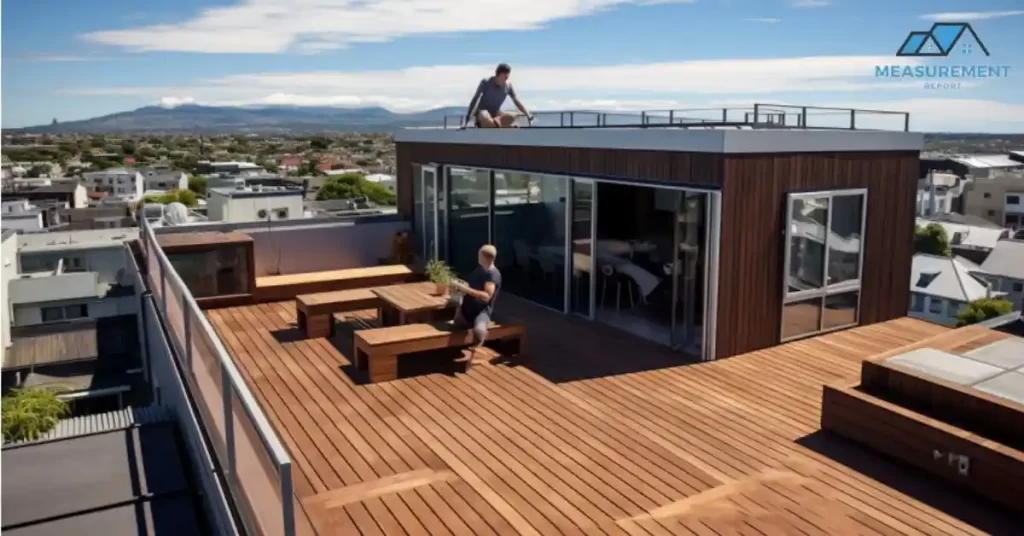
Roof decking, often interchangeably referred to as sheathing, is the layer of material attached to the structural trusses or rafters of your roof. This foundational layer acts as a base upon which all other roofing materials, such as shingles, underlayment, and insulation, are applied. Essentially, it’s the bridge between the structural components of your home and the outer elements that protect it from environmental factors.
Understanding the distinction between roof decking and sheathing is crucial. While the terms are often used synonymously, they subtly differ in their scope and application. Roof decking primarily refers to the material used as the base layer for roofing elements, usually made of sturdy materials like plywood or oriented strand board (OSB). Sheathing, on the other hand, can extend beyond roofing to include the covering of walls and floors as well.
This differentiation is not just semantic but also functional. Roof decking is specifically designed to bear the load and stresses unique to roofs, including weight distribution, weather resistance, and thermal insulation. In contrast, sheathing in walls and floors may have different requirements and attributes, focusing more on aspects like sound insulation and rigidity. By distinguishing between the two, we can better appreciate the tailored role that roof decking plays in the overall structural health and efficiency of our homes.
Types of Roof Decking Materials
The choice of materials for roof decking is pivotal, as it determines the durability, cost, and overall performance of the roof. The most commonly used materials are plywood, oriented strand board (OSB), and metal, each with its unique advantages and drawbacks.
Plywood for Roof Decking
- Advantages: Plywood, made from layered wood veneers, is renowned for its strength and resilience. It’s less prone to moisture absorption, making it a reliable choice in wet climates. Additionally, plywood provides a smooth surface, which is ideal for the application of shingles or other roofing materials.
- Disadvantages: The primary drawback of plywood is its cost, which tends to be higher than OSB. Also, if not treated properly, it can be susceptible to rot and mold over time.
- Cost: On average, plywood costs around $3 to $5 per square foot, varying based on thickness and quality.
OSB (Oriented Strand Board)
- Advantages: OSB is a cost-effective alternative to plywood, made from compressed layers of wood strands in specific orientations. It’s known for its uniformity and strength, making it a popular choice in modern construction.
- Disadvantages: OSB can swell and weaken if exposed to moisture for an extended period, which may be a concern in areas with high rainfall or humidity.
- Cost: Generally, OSB is less expensive than plywood, costing about $2 to $4 per square foot.
Metal Roof Decking
- Advantages: Metal decking, often made from aluminum or steel, offers unparalleled durability and fire resistance. It’s also lightweight and quick to install, making it a favored option for commercial and industrial buildings.
- Disadvantages: The cost of metal decking is its main disadvantage, being significantly higher than wood-based options. It also requires additional insulation layers, as metal does not provide the same level of thermal insulation.
- Cost: Metal roof decking can range from $5 to over $10 per square foot, depending on the type of metal and thickness.
When selecting the material for roof decking, it’s important to weigh these advantages against the disadvantages, considering factors such as the climate of your area, the structural requirements of your building, and your budget. Each material offers a different balance of cost, durability, and performance, making it crucial to choose one that aligns best with your specific needs and circumstances.
Installation of Roof Decking
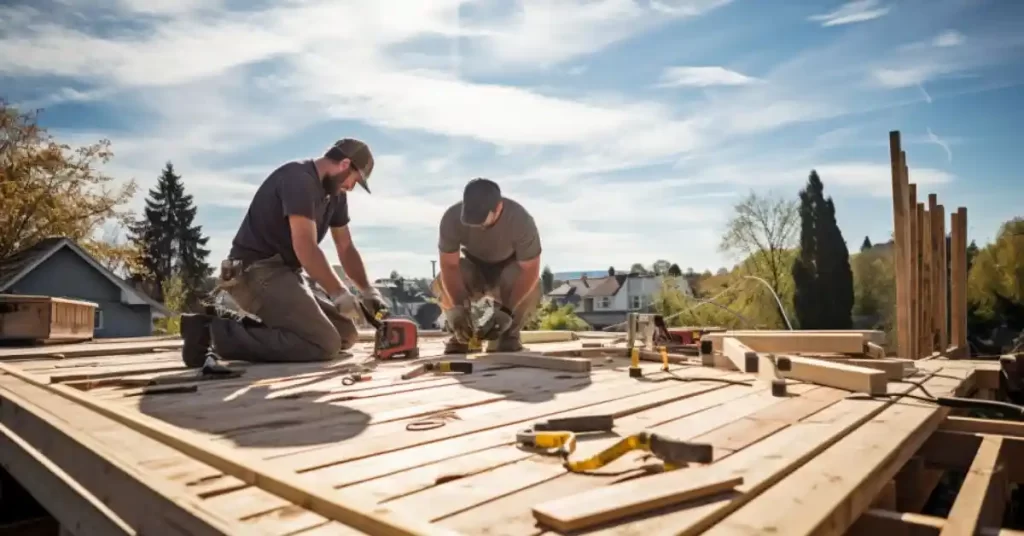
Installing roof decking is a critical phase in roofing that requires precision and understanding of the materials and techniques involved. Whether you opt for a DIY approach or professional installation, it’s important to know the steps and challenges involved.
Step-by-Step Guide on Installation
- Preparation: Begin by inspecting the roof trusses or rafters to ensure they are in good condition, level, and properly spaced.
- Material Selection: Choose the appropriate decking material (plywood, OSB, or metal) based on your roof’s requirements and budget.
- Measuring and Cutting: Measure the roof area and cut the decking material to fit. Remember to allow for a small gap between sheets to accommodate expansion.
- Laying the Decking: Start at one corner of the roof and lay the first sheet of decking. It should be perpendicular to the rafters, with the edge flush to the roofline.
- Securing the Decking: Use nails or screws to secure the decking to the rafters, ensuring that each sheet is firmly attached.
- Overlap and Sealing: Ensure that each new piece of decking overlaps the previous one to create a continuous, solid surface. Seal any joints or gaps to prevent moisture penetration.
DIY vs Professional Installation
- DIY Roof Decking: For those with carpentry skills, DIY roof decking can be a cost-effective option. However, it requires a good understanding of roofing techniques and safety measures.
- Professional Installation: Hiring professionals ensures that the installation adheres to building codes and is done safely. It’s recommended for those who lack the necessary skills or when dealing with complex roofing structures.
Common Challenges and Solutions
- Ensuring Level Installation: Uneven decking can lead to water pooling and roof damage. Use a level during installation and address any structural issues beforehand.
- Dealing with Weather Elements: Moisture can warp or damage materials. Try to install the decking in dry weather and cover unfinished areas with tarps if necessary.
- Safety Considerations: Roof work can be dangerous. Use safety equipment like harnesses and ensure the roof is stable enough to bear weight.
For beginners, it’s crucial to understand that roof decking installation is more than just laying down materials. It requires careful planning, precise execution, and adherence to safety protocols. If you’re new to roofing, consider consulting with a professional or at least getting a second opinion on your installation plan. Remember, the longevity and integrity of your roof depend significantly on how well the decking is installed.
When and Why to Replace Roof Decking
Understanding when and why to replace roof decking is essential for maintaining the structural integrity and safety of your home. Over time, factors such as weather exposure, wear and tear, and even natural aging can deteriorate your roof decking, making timely replacement crucial to avoid further damage and costly repairs.
The first step in this process is recognizing the signs that indicate the need for replacement. Visible sagging or warping of the roof is a clear indication that the decking might be weakened or damaged. This can be due to various reasons, including prolonged moisture exposure or structural stress. Similarly, if you notice water stains or signs of damage on your indoor ceilings, it could suggest that the roof decking is failing to protect your home from moisture penetration.
Mold and rot are other critical indicators. The presence of these, especially on the underside of the decking visible from the attic, points to serious moisture issues, compromising the decking’s structural integrity. Frequent roof leaks, despite regular repairs, are also a red flag signaling that the decking could be failing and might need replacement.
During a roof replacement is often an opportune time to assess and possibly replace the decking. If the existing decking is old, shows signs of previous repairs, or appears compromised in any way, it’s advisable to replace it to ensure the new roofing materials have a solid foundation.
The impact of damaged or old decking goes beyond just the surface. Compromised decking can’t adequately support the weight of roofing materials, which could lead to potential structural failures or even collapses. Additionally, damaged decking can negatively affect your roof’s insulation properties, leading to increased energy costs due to heat loss or gain.
There’s also an increased risk of water damage and leaks with old or damaged decking. This can lead to further internal structural and aesthetic damage, escalating repair costs. Moreover, inadequate decking facilitates conditions ideal for mold and mildew growth, posing potential health risks to the inhabitants.
Timely identification, inspection, and replacement of roof decking are, therefore, crucial. Regular inspections and maintenance can help identify these issues early. However, encountering any of these signs warrants consulting with a roofing professional for a thorough assessment and potential replacement. Timely repair and replacement of roof decking not only secure your home from immediate risks but also contribute to its long-term durability and value, ensuring a safe and stable roofing system for years to come.
Roof Decking Cost Considerations
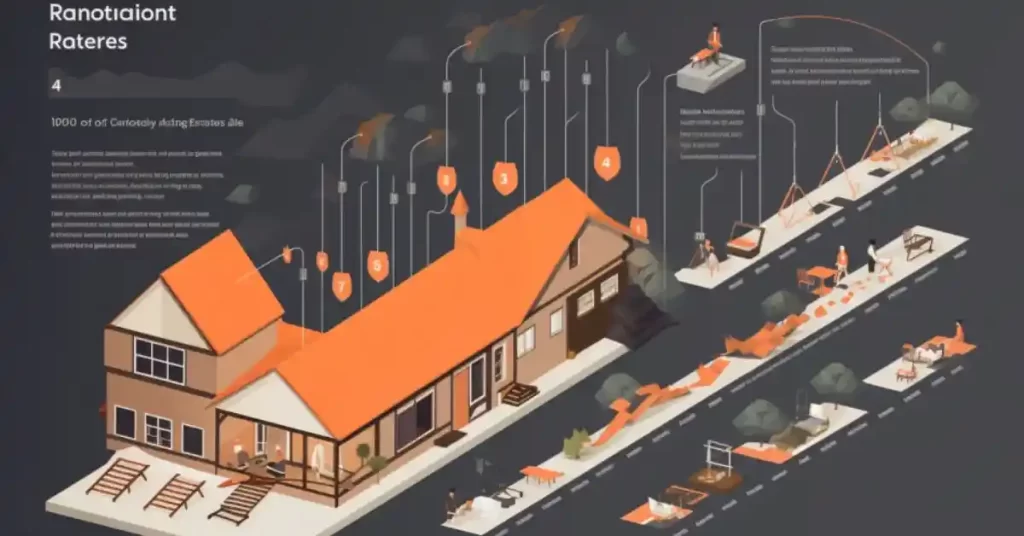
Understanding the cost considerations of roof decking is essential for homeowners and builders embarking on a roofing project. The investment in decking varies widely, influenced by several key factors. Being aware of these and adopting cost-saving strategies can help you effectively manage your budget without compromising on quality.
The primary factor impacting the cost is the choice of material. Plywood, OSB, and metal decking each come with their own price tag. Typically, metal decking is the most expensive due to its durability and longevity, while OSB is more budget-friendly. However, it’s crucial to consider not just the initial cost but also the long-term value these materials offer in terms of durability and maintenance.
Another significant factor is the size and complexity of the roof. A larger roof or one with complex features like multiple levels, steep pitches, or unique shapes will inevitably require more materials and labor, driving up the cost. Additionally, the geographic location plays a role – prices for materials and labor can vary significantly depending on the cost of living in your area.
The current condition of your roof also influences the overall expense. If the existing decking or structure requires repairs or reinforcement before installing new decking, this will increase your budget. Furthermore, labor costs can vary, influenced by factors such as the contractor’s expertise, the time of year, and the speed of installation.
However, there are ways to manage these costs effectively. Obtaining multiple quotes is a smart start; it gives you a clearer picture of the market rate in your area and helps ensure you’re getting a fair deal. When selecting materials, consider the balance between upfront costs and long-term benefits. Sometimes, a slightly more expensive option initially can be more economical in the long run due to its durability and lower maintenance needs.
Planning your project during the off-season can also lead to cost savings, as roofing services may offer lower rates during less busy times. Investing in high-quality materials and professional installation might have a higher initial cost but can lead to significant savings through reduced maintenance and repair needs over time.
For those with the necessary skills, undertaking some aspects of the project, like the removal of old decking, can cut costs. However, it’s crucial to always prioritize safety and quality. Carefully weighing these factors and tips allows you to make informed decisions about your roof decking, balancing cost, quality, and long-term performance. Remember, the cheapest option isn’t always the most cost-effective in the long run. Investing in quality materials and installation can save money by minimizing the need for future repairs and replacements.
Maintenance and Repair of Roof Decking
Maintaining and repairing your roof decking is crucial for prolonging its lifespan and ensuring the safety and integrity of your roof. Regular maintenance not only helps in identifying potential issues early but also significantly reduces the likelihood of costly repairs in the future.
Routine Maintenance Tips
- Regular Inspections: Conducting regular inspections, especially after severe weather conditions, can help you spot early signs of damage or wear.
- Clean Debris: Accumulated debris like leaves, twigs, and dirt can trap moisture against the decking, leading to rot or mold. Keeping your roof clean is a simple yet effective maintenance step.
- Ensure Proper Ventilation: Good attic ventilation prevents the buildup of heat and moisture, which can warp or damage the decking over time.
- Check for Leaks: Periodically check your attic for leaks, especially after heavy rain. Water stains on the underside of the decking can be an early indicator of problems.
Identifying and Repairing Common Issues
- Spotting Trouble Signs: Be on the lookout for signs such as sagging decking, damp insulation, or a musty smell in the attic. These could indicate problems like rot or mold.
- Repairing Minor Damage: Small areas of damage can often be repaired without replacing the entire decking. This might involve reinforcing the weakened area or patching small holes.
- Dealing with Major Issues: Extensive damage, like significant rot or widespread mold, usually requires replacing sections of the decking. This is a more complex task and often necessitates professional assistance.
- Preventing Future Problems: After repairs, take steps to prevent future issues. This might include improving roof ventilation, upgrading the underlayment, or ensuring that gutters and downspouts are functioning correctly.
For beginners, it’s important to start with basic maintenance tasks and gradually learn to identify more serious issues. If you’re ever in doubt, or if the problem seems extensive, it’s wise to consult a professional. Regularly maintaining and promptly repairing your roof decking not only extends its life but also contributes to the overall health of your home’s roofing system. Remember, proactive care is key to avoiding major repairs down the line.
Building Codes and Standards
Understanding and adhering to building codes and standards is not just about compliance; it’s a fundamental aspect of ensuring the safety and integrity of your roof decking. These codes, varying from region to region, dictate essential aspects like the thickness of the decking material, installation methods, and safety measures.
When it comes to roof decking, one of the key elements outlined in these codes is the thickness requirement. This is crucial because the thickness of your decking material directly impacts its ability to bear loads and withstand environmental stressors. For instance, in areas prone to heavy snowfall, thicker decking materials might be mandated to support the additional weight.
But why are these codes so critical? Firstly, they’re designed to protect you. By following these standards, you significantly reduce the risk of structural failures, which can lead to property damage or even injuries. Secondly, compliance is a legal necessity. Ignoring these standards can lead to penalties, complications in insurance claims, and issues when selling your property.
Therefore, whether you’re installing new decking or conducting repairs, it’s essential to familiarize yourself with the local building codes. Consulting with professionals who are well-versed in these regulations can ensure that your roofing project is not only compliant but also safe and durable.
Remember, while it might seem like an additional step, complying with these standards is an investment in the long-term safety and integrity of your home.
Underlayment and Insulation Options
When it comes to enhancing the performance and longevity of your roof decking, choosing the right underlayment and insulation is paramount. These components play a critical role not only in protecting your home from the elements but also in optimizing its energy efficiency, especially in varying climate conditions.
Options for Underlayment and Insulation
- Underlayment Options: The underlayment sits directly on your roof decking, acting as a barrier against moisture and weather elements. Common materials include asphalt-saturated felt, rubberized asphalt, and synthetic products. Each type offers different levels of water resistance, durability, and price points, allowing you to select the best fit for your roofing system.
- Insulation Choices: Insulation is key to maintaining temperature control within your home. Materials like fiberglass, cellulose, and foam insulation boards are popular. The choice depends on factors like thermal resistance (R-value), ease of installation, and compatibility with your roofing structure.
Benefits in Different Climates
- Cold Climates: In colder regions, insulating your roof decking is crucial to prevent heat loss. A well-insulated roof reduces the amount of heat escaping from the top of your house, ensuring energy efficiency and lower heating costs. It also helps prevent ice dams, a common problem in freezing temperatures, by maintaining a consistent roof temperature.
- Warm Climates: In warmer areas, the focus shifts to preventing excessive heat gain. Proper insulation and underlayment can reflect and dissipate heat, keeping your home cooler and reducing the reliance on air conditioning systems.
- Varied Climates: For regions experiencing a wide range of temperatures, selecting underlayment and insulation that provide a balance between heat retention and cooling efficiency is crucial. This might involve layered insulation solutions or specialized underlayment materials designed for thermal regulation.
The choice of underlayment and insulation should be tailored not just to your roof’s structural requirements but also to the specific climate conditions of your area. This ensures your roofing system is equipped to handle the unique challenges posed by your environment, ultimately contributing to the comfort, efficiency, and durability of your home. Whether you’re battling frigid winters or sweltering summers, the right roofing materials can make a significant difference in your home’s performance and your overall comfort.
Environmental considerations
Exploring advanced topics in roof decking reveals a dynamic field where environmental considerations and innovations play a significant role. As we become more conscious of our environmental impact and seek efficient, sustainable solutions, the roofing industry continues to evolve, introducing eco-friendly materials and innovative technologies.
Environmental Considerations
- Eco-Friendly Roof Decking: In the quest for sustainability, materials like recycled metal, sustainable wood, and composite decking made from recycled plastics and wood fibers are gaining popularity. These materials reduce the ecological footprint by utilizing recycled content and sustainable sourcing.
- Energy Efficiency: Roof decking materials can significantly influence a home’s energy efficiency. Innovations are focusing on materials that provide better insulation and reflectivity, reducing energy consumption in both cold and warm climates.
- Water Management: In areas with heavy rainfall or snow, environmentally-friendly decking options include those that facilitate better water management and reduce runoff, contributing to more sustainable water use.
Innovations and Future Trends in Roofing Materials
- Innovative Roof Decking Materials: The industry is witnessing a surge in the use of advanced materials like solar reflective decking, which reduces heat absorption, and green roofing systems, which support plant life on rooftops.
- Integration with Renewable Energy: A trend gaining momentum is the integration of renewable energy solutions into roofing, such as built-in solar panels or materials conducive to solar panel installation.
- Smart Roofing Technologies: Looking towards the future, we see the potential integration of smart technologies in roof decking. These might include materials that change properties based on weather conditions or embedded sensors to monitor structural health and environmental impact.
As we delve into these advanced topics, it’s evident that roof decking is not just a structural necessity but also a key player in the sustainable and technological advancement of home construction. Staying informed about these trends and considering environmental impacts in roofing decisions are steps towards a more sustainable, efficient, and forward-thinking approach to building and home maintenance. The future of roof decking is set to be as dynamic and innovative as the broader shifts we are witnessing in construction technologies and environmental stewardship.
Roof Decking Inspection and Checklist for Homeowners
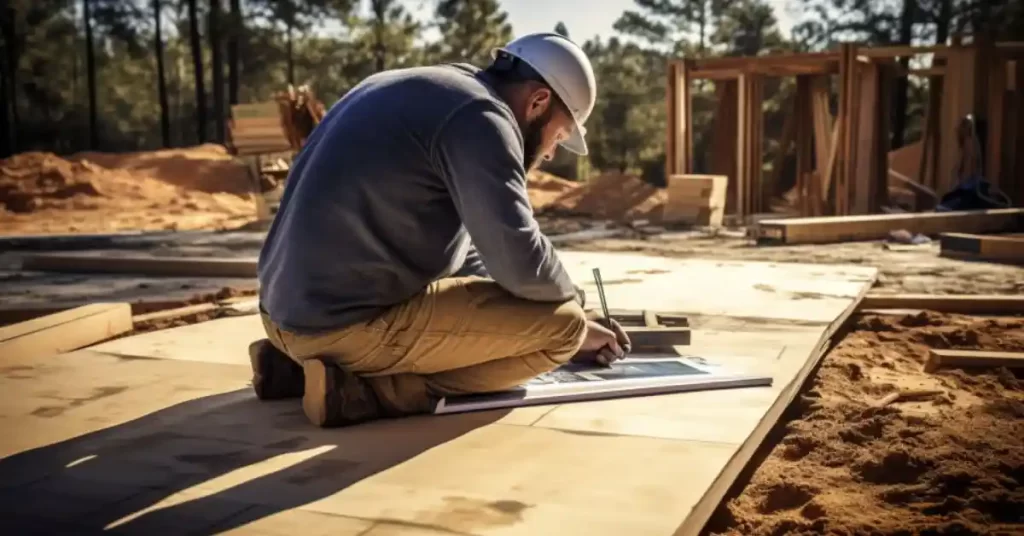
Regular inspection of your roof decking is a vital part of home maintenance, helping to identify potential issues before they escalate into major problems. Here is a checklist that homeowners can use to ensure their roof decking remains in good condition:
- Visual Inspection from the Ground
- Look for any signs of roof sagging or unevenness.
- Check for missing or damaged shingles, as these can indicate underlying decking issues.
- Attic Inspection
- Inspect the underside of the roof decking for any signs of water damage, such as dark spots or trails.
- Look for any daylight peeking through, which could indicate gaps or holes in the decking.
- Check for Mold and Mildew
- Examine the attic and decking for any signs of mold or mildew, particularly in corners and under insulation.
- Inspect for Structural Integrity
- Gently press on the roof decking from the attic to test for any soft spots, which could be a sign of rot or deterioration.
- Ensure that the decking is securely fastened to the rafters and there are no loose panels.
- Check Roof Ventilation
- Ensure that attic ventilation is adequate, as poor ventilation can lead to moisture buildup and damage the decking.
- Look for Pest or Animal Damage
- Check for any signs of pest infestation or nesting, as rodents and insects can cause significant damage to roof decking.
- Assess Insulation Condition
- Ensure that insulation is not blocking roof vents and is evenly distributed.
- Check for damp or compressed insulation, as this could indicate a leak.
- Professional Inspection
- If you notice any warning signs or are unsure about the condition of your roof decking, consider hiring a professional for a thorough inspection. They can provide expert advice and address any issues before they become serious.
Additional Tips:
- Conduct this inspection at least twice a year, ideally during the spring and fall.
- Always prioritize safety; if accessing your attic or roof is dangerous, seek professional help.
- Keep a record of your inspections to monitor any changes over time.
By regularly performing these checks, homeowners can proactively maintain their roof decking, ensuring the safety and longevity of their roof and, by extension, their home. Remember, early detection of issues can save time and money in the long run.
Roof decking benefits
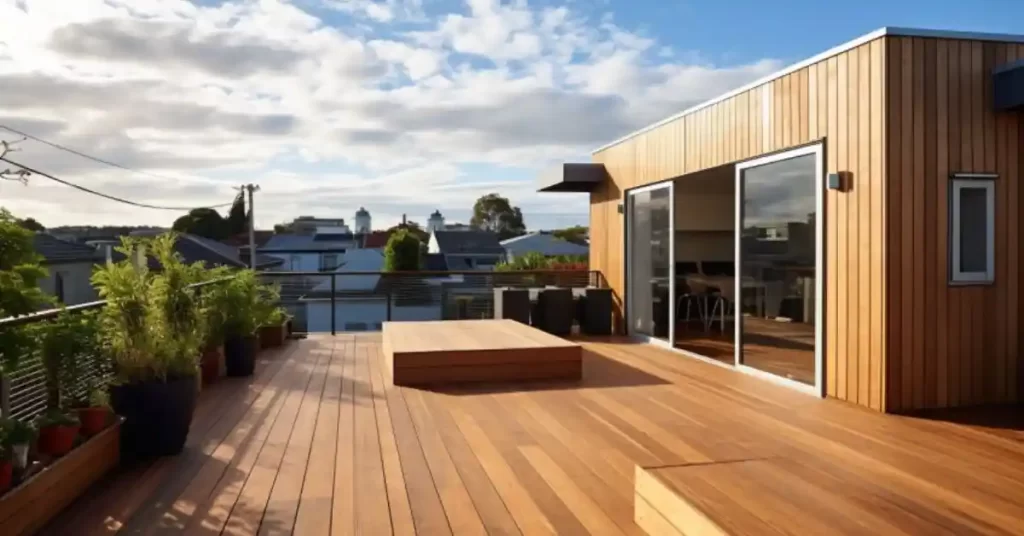
Roof decking is more than just an underlayer beneath your shingles or roofing material; it’s a foundational component that brings numerous benefits to the integrity and functionality of your roof. Primarily, it provides robust structural support, ensuring a stable base for the upper layers and evenly distributing the weight across the roof. This aspect is crucial, especially in regions experiencing heavy snowfall or frequent severe weather conditions, as it aids in bearing these additional loads without compromising the roof’s integrity.
Beyond its structural role, roof decking plays a pivotal part in weather protection. It acts as a critical line of defense against water infiltration, which is vital in preventing issues like rot, mold, and internal structural damage. This protection is especially important in maintaining the longevity of your home and safeguarding it against the elements.
Another key benefit of roof decking lies in its contribution to your home’s insulation and energy efficiency. A well-installed decking helps maintain consistent indoor temperatures, reducing the strain on your heating and cooling systems and potentially leading to significant energy savings. This aspect of roof decking is often overlooked but is essential in the overall energy performance of your home.
Furthermore, roof decking enhances the aesthetic appeal of your roof. It ensures that the roofing materials lay flat and uniform, contributing to a neat and visually appealing exterior. This not only adds to the curb appeal of your house but also ensures the optimal performance of the roofing materials.
Lastly, investing in quality roof decking can significantly increase the value of your home. It reassures potential buyers of the home’s durability and safety, making it an attractive feature in the real estate market. Also, if you’re considering future renovations or upgrades, a robust decking system will provide the necessary foundation for these enhancements, making it a wise investment for long-term home improvement plans.
In essence, roof decking is a crucial investment in the health and longevity of your home. It’s not just a component of your roofing system but a critical element that ensures structural stability, weather protection, aesthetic appeal, and energy efficiency, all of which contribute to the overall value and comfort of your home.
Conclusion
In navigating the complexities of roof decking, we’ve traversed topics ranging from the basic understanding of what roof decking is, to the nuances of installation, maintenance, and the latest innovations in the field. This journey underscores the significance of roof decking as more than just a structural component; it’s a critical element that impacts the overall integrity, efficiency, and sustainability of your home.
The choices you make in materials, whether plywood, OSB, or eco-friendly alternatives, and the care you invest in installation and maintenance, reverberate through the lifespan of your roof. Understanding the importance of building codes ensures safety and compliance, while knowledge of underlayment and insulation options empowers you to make decisions that enhance your home’s comfort and resilience, especially in the face of diverse climatic challenges.
As we look towards the future, the advancements in roof decking materials and technologies are promising, moving us closer to more sustainable, energy-efficient homes. Whether you’re a homeowner, a DIY enthusiast, or a professional in the field, staying informed and adaptable to these changes is key to successful roof decking endeavors.
In conclusion, your roof decking is a foundational aspect of your home that deserves thoughtful consideration and informed decision-making. By embracing both time-tested practices and innovative solutions, you can ensure that your roof remains not only a protective canopy over your head but also a testament to your commitment to quality, sustainability, and forward-thinking home improvement.
Related Article –
- Optimizing Roof Measurement for Solar Panels: Ultimate Guide
- Mastering Commercial Roof Measurement: Techniques and Tools
- TPO Roofing: Everything You Need to Know
- Ultimate Guide to Roof Flashing: Installation, Types, and Maintenance
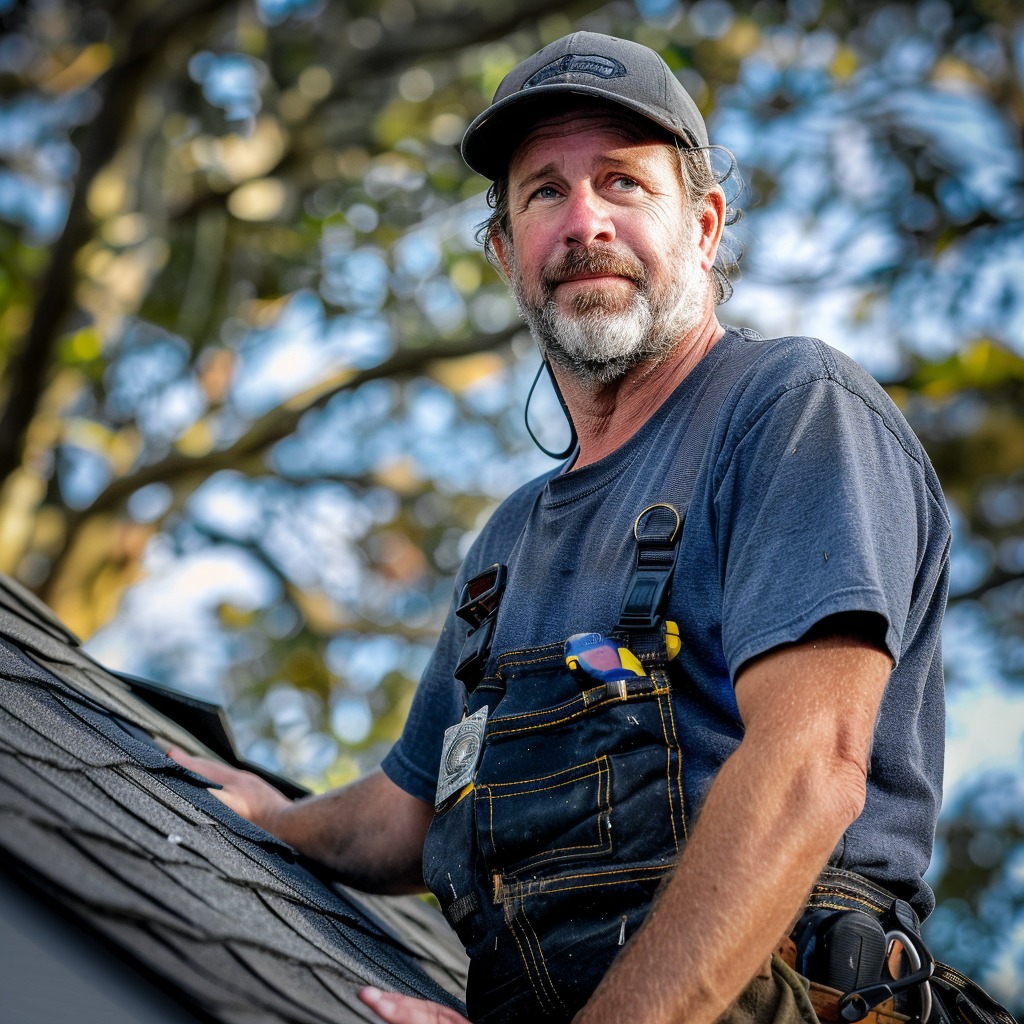
Meet William Adams, a seasoned roofing expert with over 30 years of hands-on experience in the industry. Having worked tirelessly under the scorching sun and through the fiercest storms, William brings a wealth of knowledge and expertise to the table. Hailing from the heart of the USA, he’s witnessed the evolution of roofing practices firsthand, mastering every aspect along the way. Now retired from the field, William spends his days cherishing time with his loved ones while sharing his invaluable insights through this platform. With William at the helm, you can trust that every tip, advice, and recommendation provided is backed by years of real-world experience and unwavering dedication to quality craftsmanship. Join us as we journey through the world of roofing, guided by the wisdom and passion of a true industry veteran.
